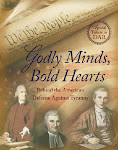

And ye shall know the truth, and the truth shall make you free. John 8:32
Albrecht Durer
As the 16th century unfolded, it was Martin Luther who took the first steps which in turn set off the Reformation. Soon after he challenged the Church, translations of the Bible from Latin into other languages got into the hands of the common people for the first time. It helped them see the beauty of Christ and the freedom He intended for us. This Reformation brought new hope and confidence to mankind, and worlds of the mind began to open up and give birth to the Renaissance.
As people began to crawl out from under guilt-ridden consciences put there by power-hungry clergymen, an interest in Humanism, science, art, and medicine emerged; and for this new-found freedom in truth, many men would give their life. It is true that reading the Bible first-hand opened the hearts, talents, and courage of many a singular man.
During this time of awakening, Albrecht Durer (1471-1528) became famous as a German painter, printmaker, and theorist. His introduction into Northern art of classical motifs, influenced by Italian artists as well as German humanists, have given him conventional regard as the greatest Northern Europe artist of his time. The high regard given him is reinforced by his theoretical treatise which involve principles of mathematics, perspective, and ideal proportions.
He had been a Roman Catholic but became affected by the Protestant writings of Martin Luther. So much did he admire Luther, he wrote in his diary,1520, of wanting to immortalize him in a drawing: "And God help me that I may go to Dr. Martin Luther; thus I intend to make a portrait of him with great care and engrave him on a copper plate to create a lasting memorial of the Christian man who helped me overcome so many difficulties."
The fear of Yahweh leads to life, then contentment; he rests and will not be touched by trouble. Proverbs 19:23
Lead me, Yahweh, in your righteousness because of my enemies. Make your way straight before my face. Psalms 5:8
Yahweh is my light and my salvation. Whom shall I fear? Yahweh is the strength of my life. Of whom shall I be afraid? Psalm 27:1
The thief cometh not, but for to steal, and to kill, and to destroy: I am come that they might have life, and that they might have it more abundantly. John 10:10
Peace I leave with you. My peace I give to you;not as the world gives, give I to you. Don’t let your heart be troubled, neither let it be fearful. John 14:27
These things I have spoken unto you, that in me ye might have peace. In the world ye shall have tribulation: but be of good cheer; I have overcome the world. John 16:33
For you didn’t receive the spirit of bondage again to fear, but you received the Spirit of adoption, by whom we cry, “Abba! Father!” Romans 8:15
But those who wait for Yahweh will renew their strength. They will mount up with wings like eagles. They will run, and not be weary. They will walk, and not faint. Isaiah 40:31
He gives power to the weak. He increases the strength of him who has no might. Isaiah 40:29
So that with good courage we say, “The Lord is my helper. I will not fear. What can man do to me?” Hebrews 13:6
Don’t you be afraid, for I am with you. Don’t be dismayed, for I am your God. I will strengthen you. Yes, I will help you. Yes, I will uphold you with the right hand of my righteousness. Isaiah 41:10
I can do all things through Christ, who strengthens me. Philippians 4:13
Finally, be strong in the Lord, and in the strength of his might. Ephesians 6:10
About one of his paintings: As an example of Durer's unique style in combination of art with his interest in medicine and its psychological concomitants with his Christianity, we turn to one of his most famous works, The Four Apostles, a painting of John, Peter, Paul, and Mark. These four embody the four temperaments as analyzed by Hippocrates: choleric, melancholic, sanguine, and phlegmatic.
In regard to another one of his other paintings, following is a legend, perhaps based upon truth, that has descended from the life of Durer:
He was born third of 18 children, all of whom lived in a small house in a small village near Nuremberg. The father, a goldsmith, worked 17-18 hours a day and, in addition, did any other paying chore he could find in the neighborhood.
Throughout the hard years, it became obvious that two of his children, Albert and Albrecht, had a natural talent for art. Even though the two boys knew full well they had no money for study at a great Academy, they harbored a dream within.
That dream shared by both of them brought about many long discussions at night until finally they worked out a pact. Upon their honor, they would, when the time was ripe, give one toss of a coin whereby the loser would go down into the nearby mines and, with his earnings, support his brother to attend the four-year Academy. Then, when that brother completed his studies, he would come home and support the other brother in going to school, either with sales of his artwork or, if necessary, also by laboring in the mines.
They tossed a coin on a Sunday morning after church, and it showed that Albrecht had won. So off he went to Nuremberg while Albert headed toward the dangerous mines. Over the next four years, Albrecht became a sensation in a very short time because his etchings, woodcuts, and paintings were far better than those of most of his professors. By the time he graduated, he was beginning to earn considerable fees for his commissioned works. He would be able to support his brother with sale of his art.
After completing his studies, Albrecht was anxious to see his family; and especially anxious was he to see and thank Albert for his sacrifice. Upon his return to the village, he found waiting for him a festive dinner to celebrate his homecoming and success. The meal, music, and sheer joy brought tears of momentary untold happiness to Albrecht. Longing to finally thank Albert, who made it all possible, and thus return the favor, he at last rose from his honored position at the head of the table to drink a toast. His closing words were, "And now, Albert, blessed brother of mine, it is your turn. Now you can go to Nuremberg to pursue your dream, and I will take care of you."
All heads turned to the far end of the table where Albert sat, sadness written all over his face. He hesitated to speak, tears streaming down his pale face while he became aware that all eyes were upon him. Finally, he rose and explained, "It is not possible now for me to study art. My hands are no longer the hands of an artist. They cannot even hold onto a brush.....the bones in every finger have been smashed at least once. And, too, I am sorry to say that lately I have been suffering from arthritis in my right hand, so much so that I cannot even hold a glass to return your toast."
So startled and saddened by the confession was Albrecht that he was never able to get over the irony of his brother's fate. Later in his career, In a fit of difficulty, he paid homage to Albert in a painting. He painstakingly drew from memory the abused hands of his brother with palms together and thin fingers stretched skyward. When finished, he called it, simply, "Hands." Today that tribute of love is known as "Praying Hands," and is by some accounts the most well-known and widely loved work of his career.
In regard to another one of his other paintings, following is a legend, perhaps based upon truth, that has descended from the life of Durer:
He was born third of 18 children, all of whom lived in a small house in a small village near Nuremberg. The father, a goldsmith, worked 17-18 hours a day and, in addition, did any other paying chore he could find in the neighborhood.
Throughout the hard years, it became obvious that two of his children, Albert and Albrecht, had a natural talent for art. Even though the two boys knew full well they had no money for study at a great Academy, they harbored a dream within.
That dream shared by both of them brought about many long discussions at night until finally they worked out a pact. Upon their honor, they would, when the time was ripe, give one toss of a coin whereby the loser would go down into the nearby mines and, with his earnings, support his brother to attend the four-year Academy. Then, when that brother completed his studies, he would come home and support the other brother in going to school, either with sales of his artwork or, if necessary, also by laboring in the mines.
They tossed a coin on a Sunday morning after church, and it showed that Albrecht had won. So off he went to Nuremberg while Albert headed toward the dangerous mines. Over the next four years, Albrecht became a sensation in a very short time because his etchings, woodcuts, and paintings were far better than those of most of his professors. By the time he graduated, he was beginning to earn considerable fees for his commissioned works. He would be able to support his brother with sale of his art.
After completing his studies, Albrecht was anxious to see his family; and especially anxious was he to see and thank Albert for his sacrifice. Upon his return to the village, he found waiting for him a festive dinner to celebrate his homecoming and success. The meal, music, and sheer joy brought tears of momentary untold happiness to Albrecht. Longing to finally thank Albert, who made it all possible, and thus return the favor, he at last rose from his honored position at the head of the table to drink a toast. His closing words were, "And now, Albert, blessed brother of mine, it is your turn. Now you can go to Nuremberg to pursue your dream, and I will take care of you."
All heads turned to the far end of the table where Albert sat, sadness written all over his face. He hesitated to speak, tears streaming down his pale face while he became aware that all eyes were upon him. Finally, he rose and explained, "It is not possible now for me to study art. My hands are no longer the hands of an artist. They cannot even hold onto a brush.....the bones in every finger have been smashed at least once. And, too, I am sorry to say that lately I have been suffering from arthritis in my right hand, so much so that I cannot even hold a glass to return your toast."
So startled and saddened by the confession was Albrecht that he was never able to get over the irony of his brother's fate. Later in his career, In a fit of difficulty, he paid homage to Albert in a painting. He painstakingly drew from memory the abused hands of his brother with palms together and thin fingers stretched skyward. When finished, he called it, simply, "Hands." Today that tribute of love is known as "Praying Hands," and is by some accounts the most well-known and widely loved work of his career.
My soul is weary with sorrow : strengthen me according to your word. Psalms 119:28
by K.L.Kraemer





















































































2 comments:
Thank you for dropping by arise 2 write. Blessings and prayers, andrea
I had a few hours to blog hop tonight and enjoyed yours. The music is great.
Hope you will stop by and visit my new Christmas blog. There is a great giveaway this week. http://grammyababychangeseverything.blogspot.com
Post a Comment